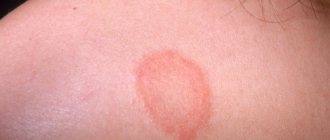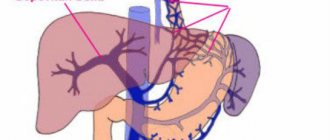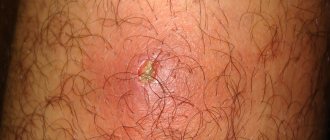Local therapist
Ablyazov
Irshat Ravilevich
21 years of experience
Local therapist of the highest category. Member of the Russian Scientific Medical Society of Therapists.
Make an appointment
Thrombocytopenia is a separate disease or a symptom of another disease that is characterized by a low platelet count (less than 150,000 units per microliter). The condition is accompanied by high bleeding, as well as slow stopping of bleeding from small vessels.
Symptoms
Symptoms of thrombocytopenia include:
- Purpura. This is the name for hemorrhages in mucous tissues or skin. In fact, it looks like red spots - most often they can be seen in places of strong contact with clothing. The spots do not hurt, they can be pinpoint or quite extensive - including bruises of different colors (depending on the time of formation).
- Regular nosebleeds. Since small vessels are weakened, bleeding can begin due to a cold, sneezing, or minor injury. Bright red blood may flow for ten minutes or more, putting the patient at risk of losing a lot of blood.
- Bleeding gums, prolonged bleeding after tooth extraction. The mechanism is the same: due to weak blood vessels, the blood cannot stop quickly in case of small or large injuries.
- Bleeding of internal organs. For example, blood is found in the gastrointestinal tract, when the stool becomes colored, or in the genitourinary system - then the urine becomes colored. Both symptoms are very alarming and require immediate contact with specialists.
- Too heavy and long menstruation. Moreover, bleeding can be observed on other days of the cycle.
All of these symptoms may indicate other diseases - both concomitant with thrombocytopenia and independent. What complicates the situation is that there are a lot of reasons and mechanisms for the development of this condition. In medicine, there are several types of this disease.
Symptoms of thrombocytopenia
The mechanism for the development of thrombocytopenia symptoms is always the same. Due to a decrease in platelet concentration, the nutrition of the walls of blood vessels is disrupted, and capillary fragility increases. At a certain moment, due to a minor physical factor or spontaneously, the integrity of the capillaries is disrupted, and severe bleeding occurs (this is usually depicted in the photo as thrombocypenia). The lack of platelets prevents the formation of a platelet plug in the burst vessels, so blood flows from the circulation into the surrounding tissues.
The main symptoms of thrombocytopenia:
- Purpura (bleeding into mucous membranes, skin). Small red spots form on the body. They do not disappear when pressed, do not hurt and do not rise above the surface of the skin. Their size can range from a few millimeters to several centimeters in diameter. At the same time, bruises may appear.
- Bleeding gums. It forms on a large surface and does not stop for a long time.
- Frequent nosebleeds. Can be caused by sneezing, microtrauma, colds. The blood that comes out is bright red. Sometimes the bleeding cannot be stopped for an hour.
- Hematuria (blood in the urine). Occurs due to hemorrhage in the mucous membranes of the bladder or urinary tract.
- Gastric and intestinal bleeding. They are a consequence of increased fragility of the vessels of the gastrointestinal mucosa, traumatizing it with rough food. The stool becomes red and bloody vomiting may occur.
- Heavy and prolonged menstrual bleeding.
If you notice similar symptoms, consult a doctor immediately. It is easier to prevent a disease than to deal with the consequences.
Classification of thrombocytopenia
Let's talk about the causes of thrombocytopenia that underlie the different types of this disease.
Hereditary thrombocytopenias
These conditions are based on diseases of genetic origin. These may be May-Hegglin anomaly, Bernard-Soulier syndrome, Wiskott-Aldrich syndrome, TAR syndrome, as well as congenital amegakaryocytic thrombocytopenia.
Each of these diseases has many characteristics. For example, Wiskott-Aldrich syndrome occurs exclusively in boys and occurs in four to ten cases per million. Bernard-Soulier syndrome can only develop in a baby who has received the altered gene from both parents, and May-Hegglin anomaly can develop in 50% of cases, provided that only one parent has the prerequisites for this. As a rule, all of these diseases have among their symptoms not only a low level of platelets, but also a number of other pathological conditions, and therefore require special treatment.
Thrombocytopenia - what is it?
Thrombocytopenia ( purpura ) is a disease in which the number of platelets in the peripheral blood decreases to less than 150,000 per microliter.
As a result, bleeding increases and the process of stopping bleeding from small vessels slows down. Thrombocytopenia in children and adults can be an independent disease (primary form) or a symptom of pathologies of other systems and organs (secondary thrombocytopenia). The problem most often occurs in preschoolers and people over 40 years of age.
According to the criterion of duration of occurrence in the body, the disease is classified into:
- Spicy. There are no immediate symptoms; thrombocytopenia affects the organs for no more than six months.
- Chronic. The decrease in platelets in the blood continues for more than six months. Treatment is long-term, taking up to two years.
Productive thrombocytopenia
They are also caused by a huge list of reasons and factors of various origins. All of them are associated with the fact that platelet formation processes in the red bone marrow are disrupted.
For example, this includes some types of anemia, cancer metastases, acute leukemia, and taking cytostatic medications. There are even factors such as radiation or alcohol abuse.
For example, in acute leukemia, a disease of the circulatory system causes a mutation in the bone marrow stem cell. Because of this, it divides and begins to displace hematopoietic cells. As a result, the number of not only platelets, but also leukocytes, erythrocytes, and lymphocytes decreases. This condition has its own name - pancytopenia. That is, immune thrombocytopenia in this case is part of it.
If we are talking about the effect of medications, then most often a decrease in platelet levels is caused by drugs from the following groups:
- antidiabetic,
- anti-inflammatory,
- antipsychotics,
- antithyroid,
- antibiotics,
- diuretics,
- anticonvulsants.
Of course, not all medications and not in all cases are capable of causing such a reaction, but this is another reason to think about the fact that you should not prescribe any medications yourself or take them without the supervision of your doctor.
Moreover, there is also such a factor as increased sensitivity to certain medications. Usually it is initially determined by a peculiar genetic predisposition, but this is quite rare.
When we talk about radiation, we are talking not only about a person’s presence in dangerous areas, but also about treatment with radiation therapy. When tumors are destroyed, the blood-forming cells of the red brain can be affected, so a condition where platelet levels drop can become a side effect of cancer treatment.
The development of symptoms of thrombocytopenia due to alcohol abuse most often occurs against the background of binge drinking and is associated with a high level of ethyl alcohol in the blood. It has negative and long-lasting effects on the bone marrow and usually causes a temporary decrease in platelets. If binge drinking becomes frequent and too long, there is a risk that the changes will be irreversible.
Publications in the media
Thrombocytopenia is a low platelet count in the peripheral blood, the most common cause of bleeding. When the platelet count decreases to less than 100´109/l, the bleeding time lengthens. In most cases, petechiae or purpura appear when the platelet count drops to 20–50´109/l. Serious spontaneous bleeding (eg, gastrointestinal) or hemorrhagic stroke occurs when thrombocytopenia is less than 10´109/L.
Etiology and pathogenesis
• Thrombocytopenia can occur as a manifestation of drug allergies (allergic thrombocytopenia), caused by the production of antiplatelet antibodies (autoimmune thrombocytopenia), caused by infections, intoxications, thyrotoxicosis (symptomatic).
• In newborns, thrombocytopenia can be caused by the penetration of autoantibodies of a sick mother through the placenta (transimmune thrombocytopenia).
• Pathology of thrombocytopoiesis •• Maturation of megakaryocytes is selectively suppressed by thiazide diuretics and other drugs, especially those used in chemotherapy, ethanol •• A special cause of thrombocytopenia is ineffective thrombopoiesis associated with the megaloblastic type of hematopoiesis (occurs with deficiency of vitamin B12 and folic acid, as well as with myelodysplastic and preleukemic syndromes). Morphologically and functionally abnormal (megaloblastic or dysplastic) megakaryocytes are identified in the bone marrow, giving rise to a pool of defective platelets that are destroyed in the bone marrow •• Amegakaryocytic thrombocytopenia is a rare cause of thrombocytopenia caused by a congenital deficiency of megakaryocyte colony-forming units.
• Anomalies in the formation of the platelet pool occur when platelets are eliminated from the bloodstream, the most common cause is deposition in the spleen •• Under normal conditions, the spleen contains a third of the platelet pool •• The development of splenomegaly is accompanied by the deposition of a larger number of cells with their exclusion from the hemostasis system. With a very large size of the spleen, it is possible to deposit 90% of the total platelet pool •• The remaining 10% in the peripheral bloodstream has a normal circulation duration.
• Increased platelet destruction in the periphery is the most common form of thrombocytopenia; Such conditions are characterized by a shortened platelet lifespan and an increased number of bone marrow megakaryocytes. These disorders are referred to as immune or nonimmune thrombocytopenic purpura • • Immune thrombocytopenic purpura • • • Idiopathic thrombocytopenic purpura (ITP) is the prototype of thrombocytopenia due to immune mechanisms (no obvious external causes of platelet destruction). See Idiopathic thrombocytopenic purpura ••• Other autoimmune thrombocytopenias caused by the synthesis of antiplatelet antibodies: post-transfusion thrombocytopenia (associated with exposure to isoantibodies), drug-induced thrombocytopenia (for example, caused by quinidine), thrombocytopenia caused by sepsis (the incidence can reach 70%), thrombocytopenia in combination with SLE and other autoimmune diseases. Treatment is aimed at correcting the underlying pathology. It is necessary to stop taking all potentially dangerous drugs. GK therapy is not always effective. Transfused platelets undergo the same accelerated destruction • • Nonimmune thrombocytopenic purpura ••• Infections (eg, viral or malaria) ••• Massive transfusion of preserved blood with a low platelet count ••• DIC ••• Prosthetic heart valves ••• Thrombotic thrombocytopenic purpura .
Genetic aspects
• Thrombocytopenia (*188000, Â). Clinical manifestations: macrothrombocytopenia, hemorrhagic syndrome, rib aplasia, hydronephrosis, recurrent hematuria. Laboratory tests: autoantibodies to platelets, shortened platelet life, increased clotting time, normal tourniquet test, defects in the plasma component of hemostasis.
• May–Hegglin anomaly (Hegglin syndrome, 155100, Â). Macrothrombocytopenia, basophilic inclusions in neutrophils and eosinophils (Döhle bodies).
• Epstein syndrome (153650, Â). Macrothrombocytopenia in combination with Allport syndrome.
• Fechtner family syndrome (153640, Â). Macrothrombocytopenia, inclusions in leukocytes, nephritis, deafness.
• Congenital thrombocytopenia (600588, deletion 11q23.3–qter, Â). Clinical manifestations: congenital dysmegakaryocyte thrombocytopenia, mild hemorrhagic syndrome. Laboratory studies: 11q23.3-qter deletion, increased number of megakaryocytes, giant granules in peripheral blood platelets.
• Cyclic thrombocytopenia (188020, Â). Hemorrhagic syndrome, cyclic neutropenia.
• Thrombocytopenia Paris–Trousseau (188025, deletion 11q23, defect of the TCPT gene, Â). Clinical manifestations: hemorrhagic syndrome, thrombocytopenia, hypertelorism, ear abnormalities, mental retardation, coarctation of the aorta, developmental delay in the embryonic period, hepatomegaly, syndactyly. Laboratory studies: giant granules in platelets, megakaryocytosis, micromegakaryocytes.
• TAR syndrome (from: t hrombocytopenia – a bsent r adius - thrombocytopenia and absence of the radius, *270400, r). Congenital absence of the radius in combination with thrombocytopenia (pronounced in children, later smoothed out); thrombocytopenic purpura; in the red bone marrow there are defective megakaryocytes; Anomalies of kidney development and congenital heart disease are sometimes noted.
The clinical picture is determined by the underlying disease that caused thrombocytopenia.
Diagnostics • Thrombocytopenia is an indication for examining the bone marrow for the presence of megakaryocytes; their absence indicates a violation of thrombocytopoiesis, and their presence indicates either peripheral destruction of platelets, or (in the presence of splenomegaly) platelet deposition in the spleen • Pathology of thrombocytopoiesis. The diagnosis is confirmed by identifying megakaryocytic dysplasia in a bone marrow smear • Abnormalities in the formation of the platelet pool. The diagnosis of hypersplenism is made when there is moderate thrombocytopenia, a normal number of megakaryocytes is detected in the bone marrow smear, and a significant enlargement of the spleen • Diagnosis of idiopathic thrombocytopenic purpura requires the exclusion of diseases associated with thrombocytopenia (for example, SLE) and thrombocytopenia caused by taking medications (for example, quinidine). Available but nonspecific methods for detecting antiplatelet antibodies are known.
TREATMENT
• Pathology of thrombocytopoiesis. Treatment is based on eliminating the offending agent, if possible, or treating the underlying disease; The half-life of platelets is usually normal, allowing platelet transfusions in the presence of thrombocytopenia and signs of bleeding. Thrombocytopenia caused by deficiency of vitamin B12 or folic acid disappears when their normal levels are restored.
• Amegakaryocytic thrombocytopenia responds well to treatment; antithymocyte immunoglobulin and cyclosporine are usually prescribed.
• Anomalies in the formation of the platelet pool. There is usually no treatment, although splenectomy may resolve the problem. During transfusions, some platelets are deposited, making transfusions less effective than in states of reduced bone marrow activity.
• Treatment of idiopathic thrombocytopenic purpura - see Idiopathic thrombocytopenic purpura.
Complications and associated conditions • Decreased platelet production is associated with aplastic anemia, myelophthisis (replacement of bone marrow by tumor cells or fibrous tissue) and some rare congenital syndromes • Evans syndrome (Fisher-Evans syndrome) - a combination of autoimmune hemolytic anemia and autoimmune thrombocytopenia.
ICD-10 • D69 Purpura and other hemorrhagic conditions
Thrombocytopenia destruction
Here we are talking about the active destruction of platelets, which is usually observed in the spleen. Such processes are also caused by a large number of factors. These include taking certain medications, some viruses, Fisher-Evans syndrome, etc.
Idiopathic thrombocytopenia deserves special consideration. This is the case when it is not possible to establish the cause even with a huge number of possible options. At the same time, doctors note that even in such a situation, the action of provoking factors is observed. For example, the problem appears after bacterial and viral infections, preventive vaccinations, use of a number of medications, hypothermia or prolonged exposure to the sun.
This condition also occurs in newborns. It begins to form in the womb, when antibodies in her body cause the destruction of platelets in the child.
Fisher-Evans syndrome is also not an independent cause, since it itself is a consequence of various systemic diseases. This syndrome occurs in systemic lupus erythematosus and rheumatoid arthritis, but in some cases it can be an independent deviation. As for viruses, rubella, chicken pox, measles, and influenza can lead to a decrease in platelet levels. Sometimes this is a reaction to vaccination, although such a mechanism is described quite rarely and almost never occurs.
Thrombocytopenia consumption
Here the mechanism is as follows: platelets, for some reason, begin to be activated in the vascular bed. In response to this, the red bone marrow begins to actively produce them - and as a result, its capabilities are slowly depleted. After this, the level of red cells begins to fall.
One of the causes of consumption thrombocytopenia is disseminated intravascular coagulation syndrome. It stands for disseminated intravascular coagulation syndrome. And it can develop against the background of severe tissue destruction during operations, burns, injuries, due to severe infections, chemotherapy, organ transplants, etc. That is, there are many underlying reasons that can cause a decrease in the level of platelets in the blood.
Diagnosis and treatment
Increased bleeding
– a reason to immediately seek advice from a specialist (hematologist), who will take a detailed medical history and prescribe the necessary examinations. The main diagnostic method is a clinical blood test, which determines the quantitative composition of platelets. The patient may also be recommended a bone marrow puncture to assess the quality of this type of hematopoiesis, ultrasound of the spleen, chest x-ray, and tests for the presence of antibodies. During pregnancy, thrombocytopenia is diagnosed using a coagulogram (blood clotting test), which allows one to determine the quantitative composition of platelets in a woman’s blood.
A serious disease such as thrombocytopenia should be treated only under the supervision of a doctor. After receiving the results of all examinations, the specialist selects individual therapeutic measures for each patient. Severe hemorrhagic syndrome requires urgent hospitalization and emergency care. For severe bleeding, platelet transfusions are indicated, and angioprotectors and fibrinolysis inhibitors are prescribed. Avoid taking acetylsalicylic acid and anticoagulants. If there is a deficiency of vitamin B12 or folic acid, medications with a high content of these elements are prescribed. This significantly improves the general condition of the patient and the results of his tests. If immune thrombocytopenia is diagnosed, a course of prednisolone will be required. The dosage is determined by the individual characteristics of the patient and his body. If drug therapy is ineffective and repeated bleeding occurs, splenectomy (removal of the spleen) is indicated. For non-immune thrombocytopenia, symptomatic hemostatic therapy is recommended.
There is no special diet for thrombocytopenia, but you should adhere to the principles of a rational, balanced diet. You should introduce more vegetables, fruits, herbs, low-fat dairy products, vegetable oils, legumes, and seafood into your diet. Alcohol consumption is strictly prohibited. Undesirable foods: white rice, sugar, baked goods, marinades and pickles.
After consulting with your doctor, you can use traditional medicine - infusions and decoctions of medicinal herbs, sesame oil.
Thrombocytopenia redistribution
If we explain this mechanism very simply, it looks like this: due to some reasons, the patient’s spleen enlarges. And if under normal conditions it stores up to 30% of platelets, then in an enlarged state it retains up to 90% of these cells. At the same time, the system does not see that there are not enough platelets and does not trigger a compensatory mechanism.
The mechanism is also based on various causes: cirrhosis of the liver, some infections such as tuberculosis, autoimmune diseases (systemic lupus erythematosus), tumors of the circulatory system, alcoholism.
Thrombocytopenia dilution
This condition is usually observed in people who receive a large number of transfusions of various liquids: for example, plasma, plasma substitutes, etc. As a result, the level of platelets decreases due to the banal dilution of the blood.
Considering the huge number of reasons that can cause immune thrombocytopenia (and we have not named all the options), a patient with its symptoms should immediately consult a doctor who will find the essence of the problem and prescribe effective treatment.
Causes
Often the cause of the disease is an allergic reaction of the body to various medications, resulting in drug-induced thrombocytopenia . With such ailment, the body produces antibodies directed against the drug. Medicines that affect the occurrence of blood cell insufficiency include sedatives, alkaloids and antibacterial agents. The causes of deficiency may also be problems with the immune system caused by the consequences of blood transfusions. The disease manifests itself especially often when blood groups do not match. Autoimmune thrombocytopenia is most often observed in the human body . In this case, the immune system is unable to recognize its platelets and rejects them from the body. As a result of rejection, antibodies are produced to remove foreign cells. If the disease has a pronounced form of an isolated disease, then it is called idiopathic thrombocytopenia or Werlhof's disease . It is believed that such thrombocytopenia occurs due to a hereditary predisposition. The manifestation of the disease is also typical in the presence of congenital immunodeficiency. A lack of platelets in the body is observed in people with a reduced composition of vitamin B12 and folic acid. Excessive radioactive or radiation exposure to cause blood cell deficiency cannot be ruled out.
Diagnostics
Since there are so many reasons, it is not possible to name diagnostic measures in detail - everything will depend on the specific situation. But we can highlight the main components of diagnosis:
- General blood analysis.
- Checking bleeding time (Duke test).
- Determining the time it takes for blood to clot.
- Red bone marrow puncture. The method allows you to identify quantitative and qualitative changes in cells.
- Determination of antibodies in blood.
- Research for genetic diseases.
- Ultrasound of internal organs. Most often, the liver and spleen are studied immediately, but this list can be very large.
- MRI. Used to study internal organs and blood vessels.
Diagnosis of the disease begins with a visit to a general practitioner, who, based on a survey, initial examinations and tests, prescribes visits to other specialists.
Treatment and severity
Treatment of thrombocytopenia most often comes down to identifying the primary disease and its treatment, as well as eliminating various unpleasant symptoms. In the process, it is also important to take into account that the severity of thrombocytopenia varies:
Mild degree. It assumes that the platelet concentration is from 50 to 150 thousand units per microliter. The condition of the capillaries is usually normal, bleeding does not develop. Usually, treatment is not necessary at this stage - doctors recommend waiting and monitoring the development of the patient’s condition.
Average degree. In this case, the concentration is 20-50 thousand platelet units per microliter. Under this condition, bleeding gums and nosebleeds are observed. If injuries and bruises occur, serious hemorrhages form in the skin. At this stage, drug therapy may be prescribed.
Severe degree. The platelet concentration is below 20 thousand, hemorrhages are spontaneous and severe. At the same time, the patient himself may feel quite comfortable, does not complain of feeling unwell, but tests show that he needs help.
Since the treatment of thrombocytopenia requires the most thorough and detailed diagnosis, it is important to choose a modern clinic that will help you. JSC "Medicine" in Moscow is just the place where you can get qualified help from the best specialists. The clinic has everything necessary for both examination and treatment of each patient.








